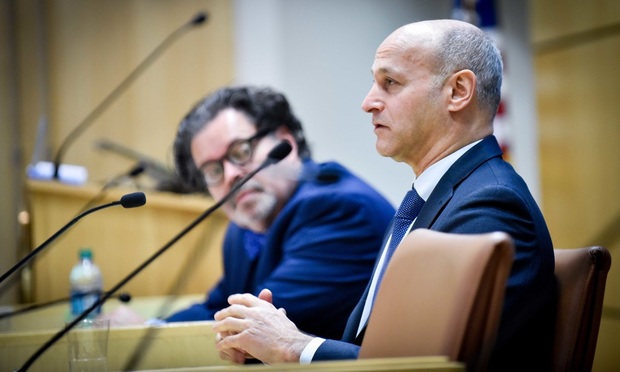Chief Administrative Judge: Reviewing Appellate Record Is Appropriate
Among the range of factors the administrative board considers is how Appellate Division (and Supreme Court) justices' decisions have fared on appeal, an entirely appropriate and relevant factor that has long been evaluated in the certification process.
January 25, 2019 at 12:36 PM
2 minute read
 Chief Administrative Judge Lawrence Marks, right, and Deputy Chief Administrative Judge George Silver greeting a new class of judges. (Photo: David Handschuh/NYLJ)
Chief Administrative Judge Lawrence Marks, right, and Deputy Chief Administrative Judge George Silver greeting a new class of judges. (Photo: David Handschuh/NYLJ)
Regrettably, David Saxe is misinformed. In his January 24, 2019 “Perspective” column in the Law Journal, the now-retired Appellate Division justice describes his concerns several years ago when he learned that, as part of the Chief Judge's Excellence Initiative, judicial performance statistics were to be reviewed by the Administrative Board of the Courts in its consideration of candidates for certification for continued judicial service pursuant to Judiciary Law §115.
The purpose and importance of such statistical review are obvious. Each grant of a two-year judicial certification decision costs the State of New York approximately $1 million (in judicial and chambers staff salary and related expenses); review of numerical measurements of past performance demonstrates both fiscal prudence and a commitment to the highest standards of judicial excellence.
Yet, contrary to Mr. Saxe's assertion, the Administrative Board has never focused on the number of Appellate Division Justices' dissenting opinions. Rather, among the range of factors the Board considers is how Appellate Division (and Supreme Court) Justices' decisions have fared on appeal, an entirely appropriate and relevant factor that has long been evaluated in the certification process.
In positing that the statistical inquiry into judicial performance “portends a change of life for my old court,” Mr. Saxe draws an alarmist conclusion from a mistaken premise, disserves former colleagues undertaking the certification process and distracts us from legitimate challenges to judicial independence against which we all must guard.
Lawrence K. Marks is the Chief Administrative Judge.
Read More:
Iron Sharpens Iron: The Value of Dissent, and Collegiality, in Appellate Courts
Why the Appellate Division Shouldn't Have To Speak in a Unified Voice
DiFiore Presses Appellate Judges to Send Fewer Appeals to High Court
This content has been archived. It is available through our partners, LexisNexis® and Bloomberg Law.
To view this content, please continue to their sites.
Not a Lexis Subscriber?
Subscribe Now
Not a Bloomberg Law Subscriber?
Subscribe Now
NOT FOR REPRINT
© 2025 ALM Global, LLC, All Rights Reserved. Request academic re-use from www.copyright.com. All other uses, submit a request to [email protected]. For more information visit Asset & Logo Licensing.
You Might Like
View All
Attorney Responds to Outten & Golden Managing Partner's Letter on Dropped Client
3 minute read
Letter to the Editor: Law Journal Used Misleading Photo for Article on Election Observers
1 minute read
NYC's Administrative Court's to Publish Some Rulings in the New York Law Journal Is Welcomed. But It Should Go Further
4 minute readTrending Stories
Who Got The Work
J. Brugh Lower of Gibbons has entered an appearance for industrial equipment supplier Devco Corporation in a pending trademark infringement lawsuit. The suit, accusing the defendant of selling knock-off Graco products, was filed Dec. 18 in New Jersey District Court by Rivkin Radler on behalf of Graco Inc. and Graco Minnesota. The case, assigned to U.S. District Judge Zahid N. Quraishi, is 3:24-cv-11294, Graco Inc. et al v. Devco Corporation.
Who Got The Work
Rebecca Maller-Stein and Kent A. Yalowitz of Arnold & Porter Kaye Scholer have entered their appearances for Hanaco Venture Capital and its executives, Lior Prosor and David Frankel, in a pending securities lawsuit. The action, filed on Dec. 24 in New York Southern District Court by Zell, Aron & Co. on behalf of Goldeneye Advisors, accuses the defendants of negligently and fraudulently managing the plaintiff's $1 million investment. The case, assigned to U.S. District Judge Vernon S. Broderick, is 1:24-cv-09918, Goldeneye Advisors, LLC v. Hanaco Venture Capital, Ltd. et al.
Who Got The Work
Attorneys from A&O Shearman has stepped in as defense counsel for Toronto-Dominion Bank and other defendants in a pending securities class action. The suit, filed Dec. 11 in New York Southern District Court by Bleichmar Fonti & Auld, accuses the defendants of concealing the bank's 'pervasive' deficiencies in regards to its compliance with the Bank Secrecy Act and the quality of its anti-money laundering controls. The case, assigned to U.S. District Judge Arun Subramanian, is 1:24-cv-09445, Gonzalez v. The Toronto-Dominion Bank et al.
Who Got The Work
Crown Castle International, a Pennsylvania company providing shared communications infrastructure, has turned to Luke D. Wolf of Gordon Rees Scully Mansukhani to fend off a pending breach-of-contract lawsuit. The court action, filed Nov. 25 in Michigan Eastern District Court by Hooper Hathaway PC on behalf of The Town Residences LLC, accuses Crown Castle of failing to transfer approximately $30,000 in utility payments from T-Mobile in breach of a roof-top lease and assignment agreement. The case, assigned to U.S. District Judge Susan K. Declercq, is 2:24-cv-13131, The Town Residences LLC v. T-Mobile US, Inc. et al.
Who Got The Work
Wilfred P. Coronato and Daniel M. Schwartz of McCarter & English have stepped in as defense counsel to Electrolux Home Products Inc. in a pending product liability lawsuit. The court action, filed Nov. 26 in New York Eastern District Court by Poulos Lopiccolo PC and Nagel Rice LLP on behalf of David Stern, alleges that the defendant's refrigerators’ drawers and shelving repeatedly break and fall apart within months after purchase. The case, assigned to U.S. District Judge Joan M. Azrack, is 2:24-cv-08204, Stern v. Electrolux Home Products, Inc.
Featured Firms
Law Offices of Gary Martin Hays & Associates, P.C.
(470) 294-1674
Law Offices of Mark E. Salomone
(857) 444-6468
Smith & Hassler
(713) 739-1250







